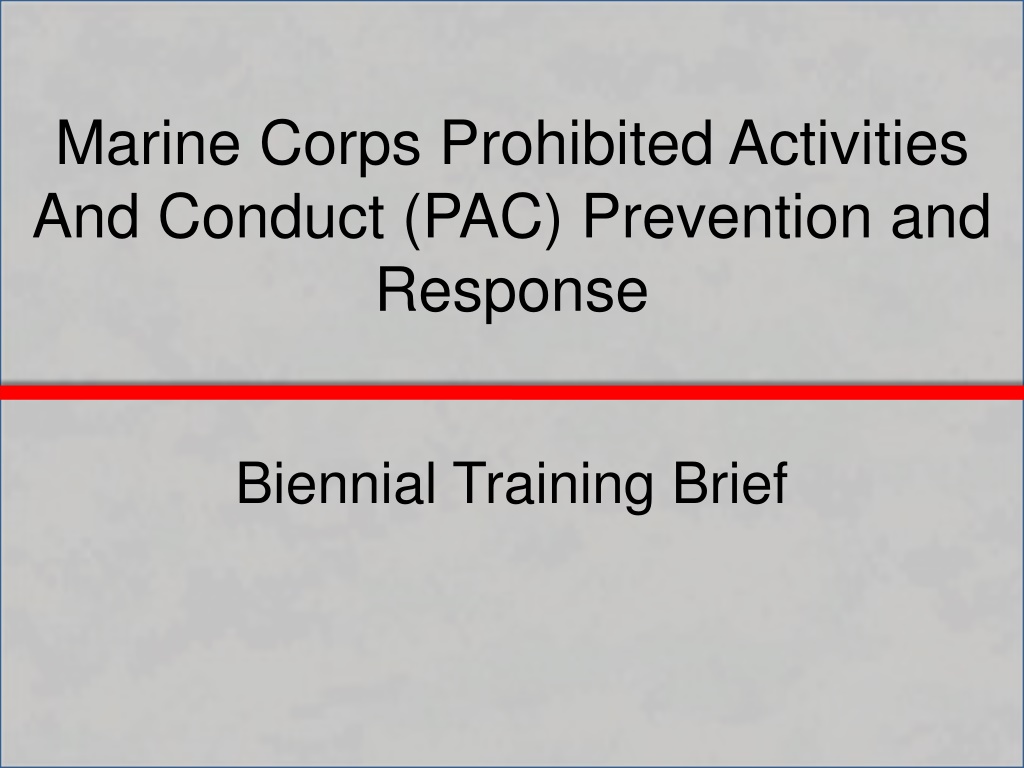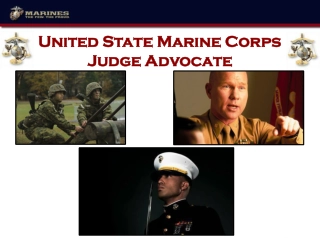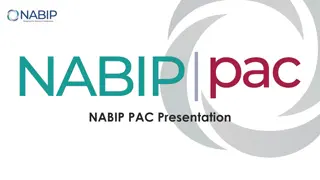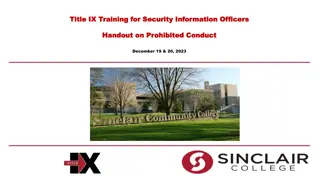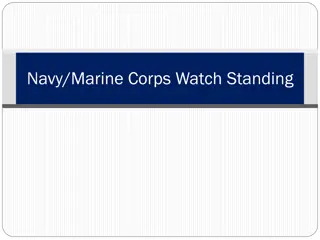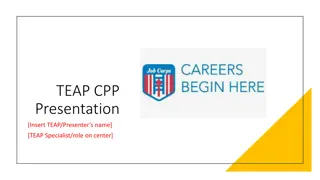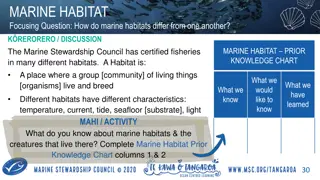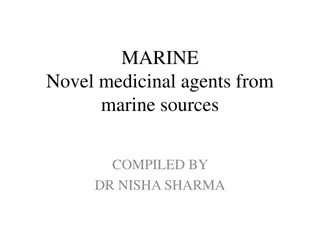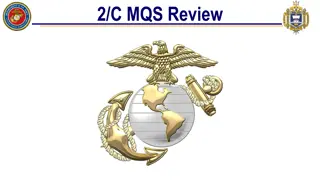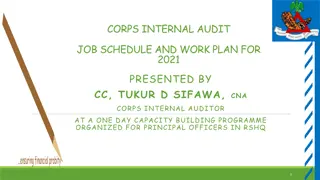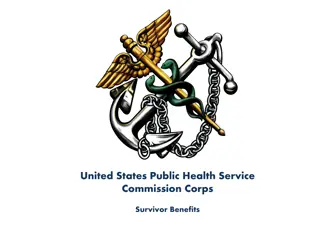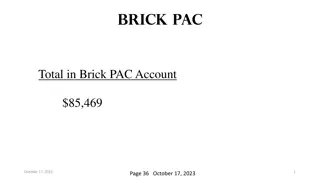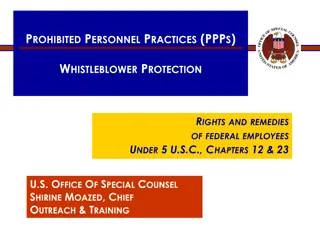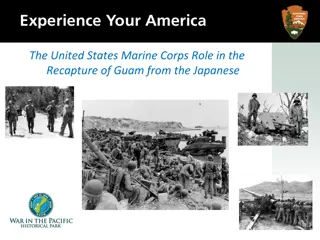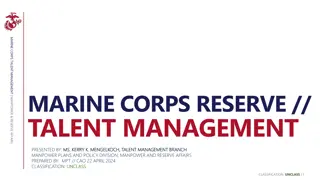Marine Corps Prohibited Activities and Conduct (PAC) Training Overview
This training provides insights into Marine Corps' intent, policies, and punitive provisions regarding prohibited activities and conduct. It covers effects of PAC on individuals and units, reporting options, roles, responsibilities, and climate assessment. The objective is to foster a professional, respectful fighting force. The content delves into punitive provisions like abuse, harassment, discrimination, and categories of abuse such as hazing and bullying.
Download Presentation

Please find below an Image/Link to download the presentation.
The content on the website is provided AS IS for your information and personal use only. It may not be sold, licensed, or shared on other websites without obtaining consent from the author. Download presentation by click this link. If you encounter any issues during the download, it is possible that the publisher has removed the file from their server.
E N D
Presentation Transcript
Marine Corps Prohibited Activities And Conduct (PAC) Prevention and Response Biennial Training Brief
Overview CMC Intent Punitive Provisions Effects of PAC on Individuals and Units Reporting Options Roles and Responsibilities Climate Assessment
Objectives By the end of this training, personnel should understand CMC s intent Marine Corps policy on PAC (definitions, consequences, victim resources) Effects of PAC on Individuals and Units Who should report and how
CMC Intent To foster a professional fighting force, and in keeping with our core values, treat and view everyone with dignity and respect.
CMC Intent To become a more cohesive and effective fighting force by investing in and leveraging Marines' collective and individual skills, strengths, knowledge, abilities, education, aptitudes, and professional development.
CMC Intent To optimize our capabilities across the force and foster the profession of arms, by establishing a culture that values the unique contributions of every Marine, both uniformed and civilian, in our Corps. Knowledge
Knowledge Check Punitive Provisions
Punitive Provisions Abuse Harassment Wrongful Distribution of an Intimate Image Dissident and Protest Activity Unlawful Discrimination Abuse
Categories of Abuse Hazing Bullying Ostracism Retaliation Hazing Ex.
Hazing Defined Any conduct whereby a Service member or DOD employee knowingly, recklessly, or intentionally and without proper authority but with a nexus to military service causes a Service member or members, regardless of Service or rank, to suffer physically or psychologically or be exposed to any activity which is cruel, abusive, humiliating, oppressive, demeaning, harmful, or creates a risk of physical or psychological injury. Hazing is evaluated by a reasonable person standard. Bullying Ex.
Examples of Hazing Rites of Passage Coercion Excessive physical exercise Illegal, harmful, or demeaning acts Bullying Ex.
Bullying Defined Any conduct whereby a Service member or DOD employee intentionally and without proper authority but with a nexus to military service excludes or rejects a Service member or members, regardless of Service or rank, through cruel, abusive, humiliating, oppressive, demeaning, or harmful behavior, which results in diminishing the member s dignity, position, or status. Bullying is evaluated by a reasonable person standard. Ostracism
Examples of Bullying Making threats, spreading rumors Physical, verbal, and/or electronic media attacks Teasing, taunting, or berating with purpose of belittling/humiliating Degrading/damaging personal property or reputation Ostracism
Ostracism Defined Any conduct whereby a Service member or DOD employee intentionally and without proper authority but with a nexus to military service excludes a Service member or members, regardless of Service or rank, from social acceptance, privilege, or friendship with the intent to inflict emotional distress, discourage the reporting of a criminal offense, or otherwise discourage the due administration of justice. Retaliation
Ostracism Excluding a service member from: Social acceptance Friendship Participation in activities With intent to: Inflict emotional distress Discourage reporting (protected communication) Retaliation
Retaliation Defined Any conduct whereby a Service member or DOD employee intentionally and without proper authority but with a nexus to military service take or threatens to take any unfavorable action or withholds or threatens to withhold a favorable action against an individual because that individual: made or was planning to report a criminal offence; engage or was preparing to engage in activity in furtherance of EEO or MEO laws or regulations; or opposed direction to engage in an action that violations law, rule, or regulation of this Order. Harassment
Retaliation Can manifest in the following ways: Reprisal or restriction Bullying Discrimination Hazing Ostracism Other ways Harassment
Harassment Defined Any conduct whereby a Service member or DOD employee knowingly, recklessly or intentionally and without proper authority but with a nexus to military service engage in conduct that is unwelcome or offensive to a reasonable person or that is unwelcome and based on race, color, religion, sex (to include gender identity), national origin, or sexual orientation, and where (1) enduring the unwelcome or offensive conduct becomes a condition of continued employment or service, or (2) the conduct is severe or pervasive enough to create a work environment that a reasonable person would consider intimidating, hostile, abusive or as otherwise having an adverse impact on the unit. Harassment Ex.
Harassment Unwelcome or Offensive Conduct or Unwelcome Conduct based on: - Race - Color - National Origin - Sex (Gender Identity) - Sexual Orientation - Religion Harassment Ex.
Examples of Harassment Offensive Jokes Slurs Name calling Display/transmit derogatory or demeaning objects/pictures SH
Sexual Harassment (SH) Defined Knowing, reckless, or intentional conduct with a nexus to military service that: 1. Involves unwelcome sexual advances, requests for sexual favors, and deliberate or repeated offensive comments or gestures of a sexual nature 2. Any knowing, reckless, or intentional use or condonation, by any person in a supervisory or command position, of any form of sexual behavior to control, influence, or affect the career, pay, or job of a Service member or DOD employee. 3. Any conduct whereby a Service member or DOD employee knowingly, recklessly, or intentionally and without proper authority but with a nexus to military service makes deliberate or repeated unwelcome verbal comments or gestures of a sexual nature. SH Ex.
Sexual Harassment (SH) Unwanted or Unwelcomed Gestures Comments Advances Requests for favors Creates Hostile/Offensive Environment SH Ex.
Examples of SH Quid Pro Quo Sexual innuendoes Lies/rumors about a person s sex life Sexist jokes/stories Inappropriate comments about clothing, body, or activities Distrobution
Wrongful Distribution or Broadcasting of an Intimate Image Defined Distribution - The act of delivering to the actual or constructive possession of another including transmission by electronic means. Broadcasting - The act of electronically transmitting the image with the intent that it be viewed by a person or persons Intimate Image Any visual deception that: (1) Includes another person who is identifiable from the depiction itself or from information conveyed in connection with the depiction (2) Depicts that person engaging in sexually explicit conduct or depicts the private areas of that person (3) Taken under the circumstances in which the person depicted has a reasonable expectation of privacy Dissident/Protest
Wrongful Distribution or Broadcasting of an Intimate Image With the intent: Of personal gain To humiliate, harm, harass, intimidate, threaten, or coerce or With reckless disregard to whether the depicted person would be humiliated, harmed, intimidated, threatened, or coerced Dissident/Protest
Dissident & Protest Activity Defined (Including Supremacist Activity) Knowing and wrongful conduct that involves actively advocating supremacist, extremist, or criminal gang doctrine, ideology, or causes, including those that advance, encourage, or advocate illegal discrimination based on race, creed, color, sex (including gender identity), religion, ethnicity, national origin, or sexual orientation or those that advance encourage, or advocate the use of force, violence, or criminal activity, or otherwise advance efforts to deprive individuals of their civil rights Discrimination
Dissident & Protest Activity (Including Supremacist Activity) Advocating or active participation in: Supremacist organizations Extremist groups Criminal gangs Discrimination
Unlawful Discrimination Defined Any conduct whereby a Service member or DoD employee knowingly and wrongfully and without proper authority but with a nexus to military service treats another Service member or DoD employee adversely or differently based on race, color, national origin, religion, sex (including gender identity) or sexual orientation. Articles
Unlawful Discrimination Six Basis for Discrimination: Race Color Religion Sex (includes Gender Identity) National Origin Sexual Orientation Articles
PAC Does Not Include Properly directed command and organizational activities, or the training to prepare for such activities (i.e. administrative corrective measures; EMI; command authorized PT) Proper verbal and written counseling addressing performance or conduct deficiencies Authorized incentive training permitted exclusively at the Recruit Depots; or similar activities properly authorized by the COC Articles
Knowledge Check Personal Effects
Effects of PAC on the Individual Physical/Psychological/Emotional harm Decreased job satisfaction Negative coping behaviors Absenteeism Impairment of Fundamental Rights Unit Effects
Effects of PAC on the Unit Loss of trust & Esprit de Corps Hostile environment Diminished organizational effectiveness Low retention rates Decreased mission readiness Report Options
Who should report Leaders must carefully monitor unit members actions and strongly encourage them to report potential PAC violations Bystanders also have responsibility to report possible PAC violations Service members might be afraid to report hazing out of fear of retaliation, so several reporting avenues are available Report Options
Reporting Options Chain of Command (Preferred) Equal Opportunity Advisor (EOA) Unit EO Representative (EOR)* Inspector General (IG) http://www.hqmc.marines.mil/igmc/Resources/Submi t-a-Complaint-/ NCIS http://www.ncis.navy.mil/ContactUs/Pages/ReportaCri me.aspx Report Options
Reporting Options Electronic Prohibited Activities and Conduct (EPAC) Portal https://www.manpower.usmc.mil/EPAC EO Advice Line (844) 818-1674 Communication with Congress Anonymous Reporting Roles
Roles & Responsibilities Chain of Command Equal Opportunity Advisor (EOA) Unit EO Representative (EOR) Individual Marine Assessment
Climate Assessment DEOMI Equal Opportunity Climate Survey (DEOCS) Required per MCO Anonymous Accessible from any web-enabled device Primary tool for assessing climate Individual responsibility Knowledge
Knowledge Check PWYE
How are PAC Violations Punished This Order is a punitive lawful general order. PAC violations may subject involved members to adverse administrative actions, nonjudicial punishment, administrative discharge, court-martial, or disciplinary action under Article 92 (Failure to obey an order or regulation) of the UCMJ or such other Articles of the UCMJ, as applicable. Substantiated PAC violations documented via pg 11, and Section I FitRep comment (considered derogatory material) Leaders who fail to address hazing can be held accountable for the actions of their subordinates Knowledge
Resources for Victims There are many resources available to victims. The initial point of contact for these resources and other services is the unit VWAC. Those who wish to maintain privacy may reach out to the: Chaplain Victims' Legal Counsel (VLC). The Marine Corps DSTRESS line now provides 24 hours a day, seven days a week, anonymous phone and chat and referral service using a Marine-to-Marine approach via 1-877-476-7734 and/or through www.marines.mil. Behavioral Health Counselors (Community Counseling Program) Sexual Assault Prevention and Response Victim Advocates Knowledge
Summary CMC Intent Punitive Provisions Effects of PAC on Individuals and Units Reporting Options Roles and Responsibilities Climate Assessment
Points of Contact EO Advice Line @ (844) 818-1674 Electronic Prohibited Activities and Conduct (EPAC) Portal https://www.manpower.usmc.mil/EPAC Command IG Office @(insert contact#) Command EOR/EOA (insert rank/name/contact info)
References/Links MCO 5354.1E W/ADMIN CH1 MCO 1900.16 DoDI 1020.03 DoD 1350.2
